The global ceramic to metal assemblies market is projected to grow from USD 2.4 billion in 2025 to approximately USD 4.8 billion by 2035, recording an absolute increase of USD 2.4 billion over the forecast period. This translates into a total growth of 98.6%, with the market forecast to expand at a compound annual growth rate (CAGR) of 7.1% between 2025 and 2035. The overall market size is expected to grow by 2.0X during the same period, supported by expanding semiconductor manufacturing applications, increasing demand for advanced electronic packages in aerospace systems, and growing requirements for hermetic sealing solutions in medical device manufacturing.
The robust market expansion reflects the critical role of ceramic-metal bonding technology in enabling next-generation electronic systems and precision instrumentation across high-reliability applications. Manufacturing facilities worldwide are increasingly adopting ceramic to metal assemblies to address thermal management challenges while maintaining electrical isolation properties, with advanced brazing techniques and metallization processes creating enhanced performance characteristics for extreme operating environments including high-vacuum applications, cryogenic systems, and demanding aerospace conditions.
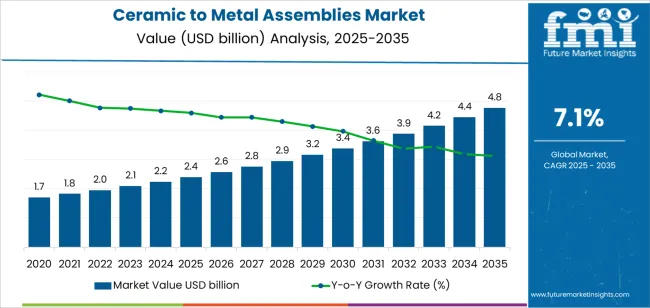
Production capabilities are advancing through specialized joining technologies and automated assembly systems that enable precise dimensional control while reducing manufacturing defects. Leading manufacturers are investing in advanced brazing furnaces and ceramic preparation equipment to create assembly products that deliver superior mechanical strength, extended thermal cycling performance, and reliable hermetic sealing under varying environmental conditions. Electronic component suppliers and packaging specialists are expanding their ceramic-metal assembly offerings to address specific application requirements across semiconductor packaging, medical implant manufacturing, laser systems, and critical aerospace applications.
Quality standards continue evolving as applications demand higher reliability specifications and consistent performance under extreme operating conditions including temperature cycling, mechanical stress, and chemical exposure. Industry certification programs and testing protocols ensure reliable product performance while supporting market confidence in ceramic-metal joining technology adoption across critical electronic systems and regulated medical device environments. Compliance requirements for aerospace applications and medical device manufacturing are driving investments in comprehensive quality assurance systems and validation procedures throughout the manufacturing supply chain.
International manufacturing coordination is supporting market development as major technology projects require standardized assembly solutions across multiple production facilities. Global electronics companies are establishing unified specifications for ceramic-metal interfaces that influence worldwide procurement standards and create opportunities for specialized assembly manufacturers. Engineering consulting firms are forming partnerships with electronic packaging suppliers to develop application-specific joining solutions tailored to emerging semiconductor requirements and advanced system specifications.
Investment patterns are shifting toward integrated manufacturing solutions as electronics facilities seek comprehensive ceramic-metal assembly systems that combine precision joining with advanced material compatibility and process control characteristics. Technology companies are implementing standardized assembly specifications across their facilities, while component manufacturers are incorporating advanced ceramic-metal joining technology into their packaging designs to ensure reliability and operational performance. This trend toward standardization and performance optimization is reshaping competitive dynamics across the electronic packaging components value chain.
Market maturation is evident in the emergence of specialized application segments that demand unique material combinations and performance specifications. Medical implant applications require biocompatible ceramic formulations and corrosion-resistant metal interfaces under strict regulatory requirements, while aerospace sensor systems need assemblies that maintain dimensional stability during extreme temperature cycling and provide consistent electrical performance in high-radiation environments. These specialized requirements are driving innovation in ceramic preparation, metallization techniques, and joining methodologies that extend beyond traditional electronic packaging applications.
| Metric | Value |
|---|---|
| Market Value (2025) | USD 2.4 billion |
| Market Forecast Value (2035) | USD 4.8 billion |
| Forecast CAGR (2025-2035) | 7.1% |
| SEMICONDUCTOR PACKAGING EXPANSION | MEDICAL DEVICE ADVANCEMENT | AEROSPACE TECHNOLOGY |
|---|---|---|
| Electronic Package Growth - Semiconductor manufacturing requiring specialized ceramic-metal assemblies for advanced chip packaging, power electronics, and high-frequency applications with enhanced thermal management properties for electronic systems, integrated circuits, and microprocessor packages requiring precise dimensional control and reliable electrical isolation performance for industrial facility compliance and system reliability requirements. | Biomedical Technology - Medical device manufacturing requiring biocompatible ceramic-metal interfaces for implantable systems, surgical instruments, and diagnostic equipment with certified material compatibility for regulatory compliance, patient safety, and long-term biocompatibility while maintaining functional performance and quality standards. | Aerospace Systems - Defense and commercial aerospace applications requiring specialized ceramic-metal assemblies for sensor packages, guidance systems, and satellite components with superior environmental resistance for extreme temperature conditions, radiation exposure, and mechanical stress while maintaining operational reliability and performance specifications. |
| Power Electronics - Industrial power system advancement requiring integrated ceramic-metal assemblies for high-voltage applications, power conversion systems, and electrical infrastructure with superior thermal conductivity and electrical isolation characteristics for power generation, distribution systems, and specialized industrial equipment applications with enhanced performance and reliability characteristics. | Surgical Equipment - Medical instrument manufacturing requiring precision ceramic-metal assemblies for minimally invasive surgical tools, imaging systems, and therapeutic devices with documented performance and certification requirements for medical facility installations and patient treatment applications requiring proven performance and regulatory compliance documentation. | Satellite Technology - Space system requirements requiring certified ceramic-metal assemblies for communication satellites, navigation systems, and scientific instruments with comprehensive environmental resistance for space applications, orbital conditions, and mission-critical system reliability with specialized design characteristics and performance specifications. |
| System Integration - Electronic component suppliers implementing comprehensive ceramic-metal solutions for advanced packaging projects, system installations, and equipment upgrades with specialized design characteristics and performance specifications for enhanced reliability, thermal management, and electrical performance across diverse industrial and commercial applications. | Regulatory Compliance - Medical device standards requiring certified ceramic-metal performance for manufacturing facilities, device installations, and patient safety with comprehensive compliance documentation and testing validation for regulatory approval processes and quality assurance systems. | Environmental Resistance - Aerospace material requirements requiring durable ceramic-metal solutions for extreme environments, long-term missions, and critical system applications with proven performance and reliability characteristics for demanding operational conditions and service requirements. |
| Category | Segments / Values |
|---|---|
| By Type | Alumina Assemblies; Zirconia Assemblies; Aluminum Nitride Assemblies; Beryllia Assemblies; Silicon Carbide Assemblies; Others |
| By Application | Medical Implants; X-Ray and Laser Tubes; Aerospace Sensors; Cryogenic and Superconducting Systems; Semiconductor Packaging; Electronic Components; Others |
| By End-User | Electronic Component Manufacturers; Medical Device Companies; Aerospace and Defense Contractors; Semiconductor Manufacturers; Research Institutions; Others |
| By Joining Method | Active Metal Brazing; Diffusion Bonding; Friction Welding; Thermal Compression; Direct Bonding; Others |
| By Metal Type | Stainless Steel; Titanium; Kovar; Copper; Molybdenum; Tungsten; Others |
| By Region | North America; Europe; Asia Pacific; Latin America; Middle East & Africa |
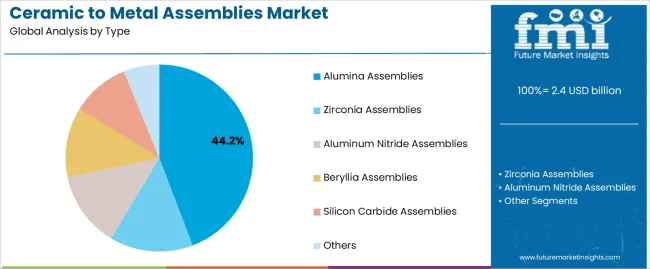
| Segment | 2025-2035 Outlook |
|---|---|
| Alumina Assemblies | Leader in 2025 with 44.2% market share; most widely used ceramic material for electronic packaging and medical applications requiring reliable electrical insulation and mechanical strength. Widely adopted across semiconductor manufacturing and medical device production. Momentum: strong growth across electronic packaging and medical implant segments. Watchouts: competition from advanced ceramic materials in high-performance applications. |
| Zirconia Assemblies | Growing segment with 23.7% share, favored for medical implant applications and high-temperature environments requiring superior mechanical properties and biocompatibility. Momentum: exceptional growth in medical device and aerospace applications. Watchouts: higher material costs compared to standard alumina solutions in cost-sensitive applications. |
| Aluminum Nitride Assemblies | Specialized segment serving high-thermal-conductivity applications requiring efficient heat dissipation for power electronics and semiconductor cooling systems. Momentum: steady growth in power electronics and thermal management applications. Watchouts: limited application scope compared to general-purpose ceramic alternatives. |
| Others | Includes beryllia assemblies, silicon carbide assemblies, and specialty ceramic types for unique application requirements. Momentum: selective growth in specialized aerospace and research applications. |
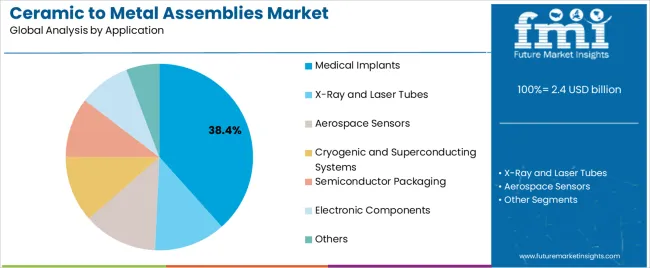
| Segment | 2025-2035 Outlook |
|---|---|
| Medical Implants | Largest application segment in 2025 at 38.4% share, driven by aging population demographics and advancing medical technology requiring biocompatible ceramic-metal interfaces for orthopedic implants, dental systems, and cardiovascular devices. Momentum: robust growth from medical device innovation and regulatory approval expansion. Watchouts: strict regulatory requirements and lengthy approval processes in medical device markets. |
| X-Ray and Laser Tubes | Critical segment representing 24.8% share, experiencing steady growth from medical imaging advancement and industrial inspection applications requiring reliable vacuum sealing and thermal management capabilities. Momentum: consistent growth as medical facilities upgrade imaging equipment and industrial quality control systems expand. Watchouts: competition from alternative sealing technologies and equipment miniaturization trends. |
| Aerospace Sensors | Growing segment at 18.3% share for specialized aerospace applications, satellite systems, and defense equipment requiring hermetic sealing and environmental resistance for extreme operating conditions. Momentum: moderate growth from space exploration initiatives and defense modernization programs. Watchouts: long development cycles and qualification requirements limiting rapid market adoption. |
| Others | Includes cryogenic systems, superconducting applications, semiconductor packaging, and emerging electronic applications. Momentum: diverse growth opportunities across multiple technology sectors and specialized applications. |
| End-User | Status & Outlook (2025-2035) |
|---|---|
| Electronic Component Manufacturers | Dominant end-user in 2025 with 52.1% share for semiconductor packaging and electronic system applications requiring reliable thermal management and electrical isolation properties. Provides operational efficiency, product reliability, and performance optimization for electronic manufacturing operations. Momentum: steady growth driven by electronics miniaturization and power density advancement. Watchouts: cost pressure and performance specification requirements across diverse electronic applications. |
| Medical Device Companies | Technology-focused end-user serving implantable device applications and surgical instrument manufacturing requiring certified biocompatibility and regulatory compliance specifications. Momentum: strong growth as medical device innovation advances and aging demographics drive implant demand. Watchouts: regulatory complexity and validation requirements in medical device development processes. |
| Aerospace and Defense Contractors | Specialized end-user for mission-critical applications and environmental resistance requirements serving satellite systems, defense equipment, and space exploration projects. Momentum: moderate growth as space programs expand and defense systems modernize. Watchouts: qualification timelines and performance validation requirements for aerospace applications. |
| Others | Includes semiconductor manufacturers, research institutions, and emerging technology end-user categories. Momentum: selective growth opportunities in specialized applications and emerging technology sectors. |
| KEY TRENDS | DRIVERS | RESTRAINTS |
|---|---|---|
| Advanced Joining Technologies - Development of precision brazing techniques and metallization processes delivering enhanced bond strength, thermal cycling resistance, and hermetic sealing capabilities for demanding electronic and medical applications with improved reliability characteristics and extended service life performance specifications. | Electronics Miniaturization - Semiconductor industry advancement requiring sophisticated ceramic-metal assemblies for compact electronic packages, power density management, and thermal dissipation solutions supporting miniaturized devices, integrated circuits, and high-performance computing systems requiring effective heat management and electrical isolation compliance. | Manufacturing Complexity in production processes and quality control requirements creating technical barriers for assembly manufacturers and increasing production costs across precision joining operations, specialized equipment investments, and comprehensive testing procedures for diverse industrial applications. |
| Biocompatible Material Development - Advanced ceramic formulations and metal interface technologies enabling medical implant applications with superior biocompatibility, corrosion resistance, and mechanical properties for long-term implantable devices and surgical instrument manufacturing. | Medical Device Innovation - Healthcare technology advancement driving adoption of ceramic-metal assemblies for implantable systems, diagnostic equipment, and surgical instruments requiring biocompatible materials, regulatory compliance, and proven long-term performance for patient safety and medical facility applications. | Regulatory Requirements - Complex approval processes and certification standards for medical device applications, aerospace systems, and electronic components creating development timelines and validation costs affecting market entry and product commercialization across regulated industries. |
| Thermal Management Solutions - Integration with advanced cooling systems, heat sink technologies, and thermal interface applications enabling comprehensive temperature control for high-power electronics, laser systems, and power conversion equipment requiring superior thermal conductivity and electrical isolation capabilities. | Aerospace Technology - Defense and commercial space applications requiring specialized ceramic-metal assemblies for extreme environmental conditions, radiation resistance, and long-term reliability supporting satellite systems, guidance equipment, and scientific instrumentation with proven performance specifications. | Material Cost Pressures - Advanced ceramic materials and precision manufacturing processes creating cost challenges for price-sensitive applications and budget constraints limiting adoption of premium ceramic-metal assembly solutions across competitive industrial and commercial markets. |

| Country | CAGR (2025-2035) |
|---|---|
| China | 9.6% |
| India | 8.9% |
| Germany | 8.2% |
| Brazil | 7.5% |
| United States | 6.7% |
| United Kingdom | 6% |
| Japan | 5.3% |
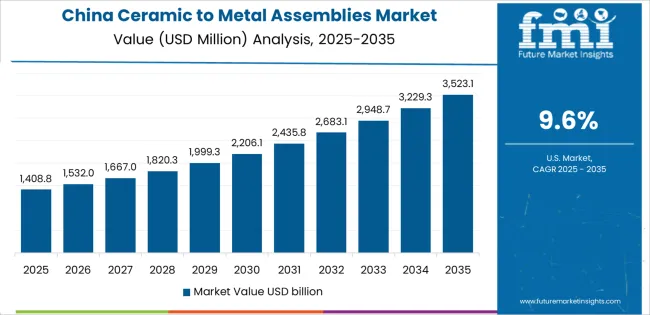
Revenue from ceramic to metal assemblies in China is projected to exhibit exceptional growth with a market value of USD 1.2 billion by 2035, driven by extensive electronics manufacturing expansion and comprehensive semiconductor industry development creating substantial opportunities for assembly technology suppliers across electronic packaging systems, medical device manufacturing, and industrial equipment production sectors. The country's ambitious technology advancement programs including national semiconductor development initiatives and medical device manufacturing expansion are creating consistent demand for specialized ceramic-metal assembly systems. Major manufacturing companies and electronics suppliers including BOE Technology, BYD Electronics, and specialized ceramic component manufacturers are establishing comprehensive assembly solution programs to support large-scale electronics production and advanced manufacturing technology applications.
Revenue from ceramic to metal assemblies in India is expanding to reach USD 387.2 million by 2035, supported by extensive electronics manufacturing development programs and comprehensive technology infrastructure modernization initiatives creating demand for ceramic-metal assembly solutions across diverse manufacturing facility and electronics system application segments. The country's growing electronics manufacturing capabilities and expanding medical device infrastructure are driving demand for assembly components that provide exceptional reliability while supporting advanced manufacturing system requirements. Technology companies and manufacturing facilities are investing in ceramic-metal assembly technology to support growing production demand and electronics manufacturing advancement requirements.
Demand for ceramic to metal assemblies in Germany is projected to reach USD 743.1 million by 2035, supported by the country's leadership in precision manufacturing technology and advanced electronic systems requiring sophisticated ceramic-metal assembly solutions for automotive electronics and medical device applications. German manufacturing operators are implementing cutting-edge assembly platforms that support advanced operational capabilities, precision performance, and comprehensive quality monitoring protocols. The market is characterized by focus on engineering excellence, technology innovation, and compliance with stringent industrial safety and performance standards.
Revenue from ceramic to metal assemblies in Brazil is growing to reach USD 267.8 million by 2035, driven by industrial technology development programs and increasing electronics manufacturing capabilities creating opportunities for assembly suppliers serving both electronics manufacturers and specialized medical device contractors. The country's expanding technology sector and growing industrial infrastructure are creating demand for assembly components that support diverse manufacturing requirements while maintaining performance standards. Technology companies and manufacturing facilities are developing assembly strategies to support operational efficiency and system reliability advancement.
Demand for ceramic to metal assemblies in United States is projected to reach USD 982.5 million by 2035, expanding at a CAGR of 6.7%, driven by advanced electronics technology innovation and specialized aerospace applications supporting semiconductor manufacturing and comprehensive medical device technology applications. The country's established technology innovation tradition including major electronics manufacturers and medical device facilities are creating demand for high-performance ceramic-metal assembly components that support operational advancement and safety standards. Manufacturers and technology system suppliers are maintaining comprehensive development capabilities to support diverse electronics and medical device requirements.
Revenue from ceramic to metal assemblies in United Kingdom is growing to reach USD 432.7 million by 2035, supported by electronics technology heritage and established precision manufacturing communities driving demand for premium ceramic-metal assembly solutions across traditional electronics systems and specialized aerospace applications. The country's rich technology engineering heritage including major manufacturing companies and established electronics system capabilities create demand for assembly components that support both legacy system advancement and modern electronics applications.
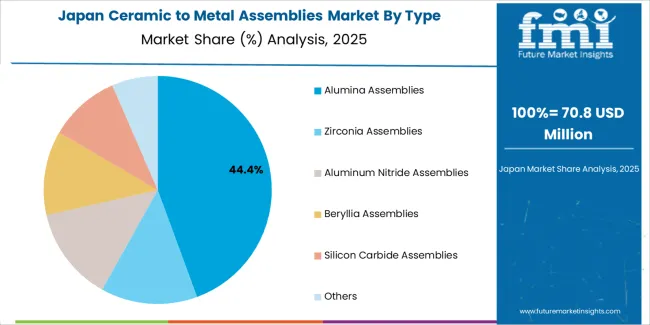
Demand for ceramic to metal assemblies in Japan is projected to reach USD 498.9 million by 2035, driven by precision electronics technology tradition and established industrial leadership supporting both domestic electronics system markets and export-oriented component production. Japanese companies maintain sophisticated ceramic-metal assembly development capabilities, with established manufacturers continuing to lead in assembly technology and electronics equipment standards.
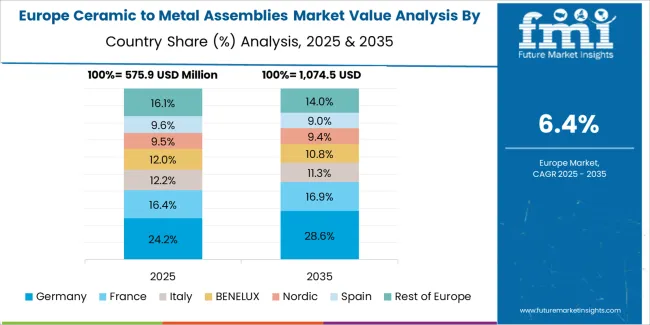
European ceramic to metal assembly operations are increasingly concentrated between German engineering excellence and specialized manufacturing across multiple countries. German facilities dominate high-performance ceramic-metal assembly production for automotive electronics and medical device applications, leveraging cutting-edge joining technologies and strict quality protocols that command price premiums in global markets. British technology operators maintain leadership in aerospace system innovation and ceramic-metal assembly method development, with organizations like specialized engineering companies and university research centers driving technical specifications that suppliers must meet to access major aerospace contracts.
Eastern European operations in Czech Republic and Poland are capturing specialized production contracts through precision manufacturing expertise and EU compliance standards, particularly in electronic component fabrication and assembly technologies for medical applications. These facilities increasingly serve as development partners for Western European manufacturing programs while building their own technology expertise.
The regulatory environment presents both opportunities and constraints. European medical device framework requirements create quality standards that favor established European manufacturers and technology system operators while ensuring consistent performance specifications for critical healthcare infrastructure and safety applications. Brexit has created complexity for UK technology collaboration with EU programs, driving opportunities for direct relationships between British operators and international ceramic-metal assembly suppliers.
Technology collaboration accelerates as electronics companies seek assembly advancement to support major product development milestones and system integration timelines. Vertical integration increases, with major technology system operators acquiring specialized manufacturing capabilities to secure component supplies and quality control for critical electronics programs. Smaller technology contractors face pressure to specialize in niche applications or risk displacement by larger, more comprehensive operations serving mainstream electronics and medical device requirements.
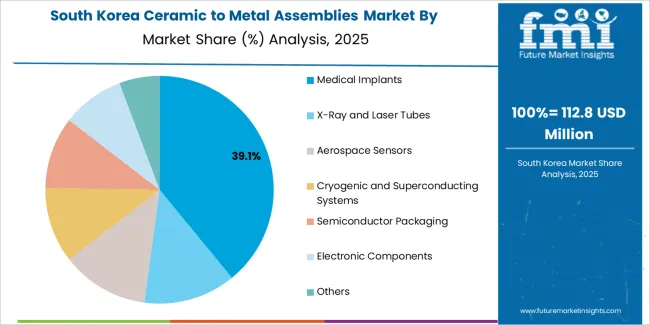
South Korean ceramic to metal assembly operations reflect the country's advanced electronics technology capabilities and export-oriented technology development model. Major technology system operators including Samsung Electronics and LG Electronics drive component procurement strategies for their manufacturing facilities, establishing direct relationships with specialized ceramic-metal assembly suppliers to secure consistent quality and performance for their technology development programs and advanced electronics technology systems targeting both domestic infrastructure and international collaboration projects.
The Korean market demonstrates particular strength in integrating ceramic-metal assembly technologies into semiconductor packaging platforms and advanced electronics system configurations, with engineering teams developing solutions that bridge traditional electronics assembly applications and next-generation technology systems. This integration approach creates demand for specific performance specifications that differ from conventional applications, requiring suppliers to adapt assembly capabilities and system coordination characteristics.
Regulatory frameworks emphasize electronics safety and manufacturing system reliability, with Korean technology standards often exceeding international requirements for ceramic-metal assembly systems. This creates barriers for standard component suppliers but benefits established manufacturers who can demonstrate electronics-grade performance capabilities. The regulatory environment particularly favors suppliers with Korean technology system qualification and comprehensive testing documentation systems.
Supply chain excellence remains critical given Korea's electronics focus and international collaboration dynamics. Technology system operators increasingly pursue development partnerships with suppliers in Japan, Germany, and specialized manufacturers to ensure access to cutting-edge ceramic-metal assembly technologies while managing infrastructure risks. Investment in technology infrastructure supports performance advancement during extended electronics development cycles.

Saint-Gobain leads the market with 18.7% share owing to its comprehensive ceramic materials portfolio and established electronics manufacturing relationships, which manufacturers use to implement integrated assembly solutions across diverse electronic and medical applications. Profit pools are consolidating upstream in advanced material development and downstream in application-specific solutions for medical devices, aerospace systems, and specialized electronics markets where biocompatibility, environmental resistance, and precision joining command substantial premiums. Value is migrating from basic ceramic-metal joining production to specification-driven, application-ready assembly systems where materials expertise, precision manufacturing, and reliable integration capabilities create competitive advantages.
Several archetypes define market leadership: established American materials companies defending share through comprehensive ceramic technology development and proven medical device support; German precision manufacturers leveraging engineering excellence and quality capabilities; Japanese technology leaders with electronics expertise and precision manufacturing heritage; and emerging Asian manufacturers pursuing cost-effective production while developing advanced joining capabilities.
Switching costs - material qualification, assembly process validation, regulatory certification - provide stability for established suppliers, while technological advancement requirements and specialized application growth create opportunities for innovative assembly manufacturers. Consolidation continues as companies seek manufacturing scale; direct technology partnerships grow for specialized applications while traditional electronics distribution remains relationship-driven. Focus areas: secure premium medical device and aerospace market positions with application-specific performance specifications and technical collaboration; develop ceramic-metal joining technology and advanced manufacturing capabilities; explore specialized applications including semiconductor packaging and cryogenic system requirements.
| Stakeholder Type | Primary Advantage | Repeatable Plays |
|---|---|---|
| American Materials Leaders | Comprehensive materials expertise; proven medical device integration; established manufacturer relationships | Precision manufacturing; technical innovation; medical certification support |
| German Precision Manufacturers | Manufacturing excellence; comprehensive quality development programs; established customer partnerships | Engineering collaboration focus; integrated solutions; technical consultation |
| Japanese Technology Leaders | Electronics system expertise; precision technology leadership; trusted by major technology programs | Technology partnerships; application-specific specifications; electronics infrastructure collaboration |
| Emerging Asian Producers | Manufacturing efficiency; competitive pricing; rapid technology development | Production scaling; technology advancement; market entry strategies |
| Technology Distributors | Technical distribution networks; manufacturing service relationships | Technology expertise; inventory management; technical support services |
| Item | Value |
|---|---|
| Quantitative Units | USD 2.4 billion |
| Type Segments | Alumina Assemblies; Zirconia Assemblies; Aluminum Nitride Assemblies; Beryllia Assemblies; Silicon Carbide Assemblies; Others |
| Applications | Medical Implants; X-Ray and Laser Tubes; Aerospace Sensors; Cryogenic and Superconducting Systems; Semiconductor Packaging; Electronic Components; Others |
| End-Users | Electronic Component Manufacturers; Medical Device Companies; Aerospace and Defense Contractors; Semiconductor Manufacturers; Research Institutions; Others |
| Joining Methods | Active Metal Brazing; Diffusion Bonding; Friction Welding; Thermal Compression; Direct Bonding; Others |
| Metal Types | Stainless Steel; Titanium; Kovar; Copper; Molybdenum; Tungsten; Others |
| Regions Covered | North America; Latin America; Europe; Asia Pacific; Middle East & Africa |
| Key Countries | China; India; Germany; Brazil; United States; United Kingdom; Japan (+35 additional countries) |
| Key Companies Profiled | Saint-Gobain; Morgan Advanced Materials; CeramTec; Hermetic Solutions Group; Materion; KYOCERA; CoorsTek; NGK; Murata; Toshiba; Microcertec; 3X Ceramic Parts; Solcera; Umicore Ceramics; SCT Ceramics |
| Additional Attributes | Dollar sales by type and application; Regional demand trends (NA, EU, APAC); Competitive landscape; Medical vs. electronics adoption patterns; Semiconductor packaging and electronic component integration; Advanced material innovations driving performance enhancement, joining reliability, and medical device excellence |
The global ceramic to metal assemblies market is estimated to be valued at USD 2.4 billion in 2025.
The market size for the ceramic to metal assemblies market is projected to reach USD 4.8 billion by 2035.
The ceramic to metal assemblies market is expected to grow at a 7.1% CAGR between 2025 and 2035.
The key product types in ceramic to metal assemblies market are alumina assemblies, zirconia assemblies, aluminum nitride assemblies, beryllia assemblies, silicon carbide assemblies and others.
In terms of application, medical implants segment to command 38.4% share in the ceramic to metal assemblies market in 2025.






Full Research Suite comprises of:
Market outlook & trends analysis
Interviews & case studies
Strategic recommendations
Vendor profiles & capabilities analysis
5-year forecasts
8 regions and 60+ country-level data splits
Market segment data splits
12 months of continuous data updates
DELIVERED AS:
PDF EXCEL ONLINE
Ceramic Textile Market Size and Share Forecast Outlook 2025 to 2035
Ceramic and Porcelain Tableware Market Size and Share Forecast Outlook 2025 to 2035
Ceramic Matrix Composites Market Size and Share Forecast Outlook 2025 to 2035
Ceramic Frit Market Size and Share Forecast Outlook 2025 to 2035
Ceramic Substrates Market Size and Share Forecast Outlook 2025 to 2035
Ceramic 3D Printing Market Size and Share Forecast Outlook 2025 to 2035
Ceramic Injection Molding Market Size and Share Forecast Outlook 2025 to 2035
Ceramic Tableware Market Size and Share Forecast Outlook 2025 to 2035
Ceramic Paper Market Size and Share Forecast Outlook 2025 to 2035
Ceramic Balls Market Size and Share Forecast Outlook 2025 to 2035
Ceramic Tester Market Size and Share Forecast Outlook 2025 to 2035
Ceramic Membranes Market Analysis - Size, Share and Forecast Outlook 2025 to 2035
Ceramic Barbeque Grill Market Analysis - Size, Share, and Forecast Outlook 2025 to 2035
Ceramic Tiles Market Growth & Trends 2025 to 2035
Ceramic Sanitary Ware Market Trends & Forecast 2025 to 2035
Ceramic Transducers Market Growth - Trends & Forecast 2025 to 2035
Leading Providers & Market Share in Ceramic Barbeque Grill Industry
Ceramic Ink Market
Ceramic Coating Market Growth – Trends & Forecast 2024-2034
Ceramic Additives Market

Thank you!
You will receive an email from our Business Development Manager. Please be sure to check your SPAM/JUNK folder too.
Chat With
MaRIA